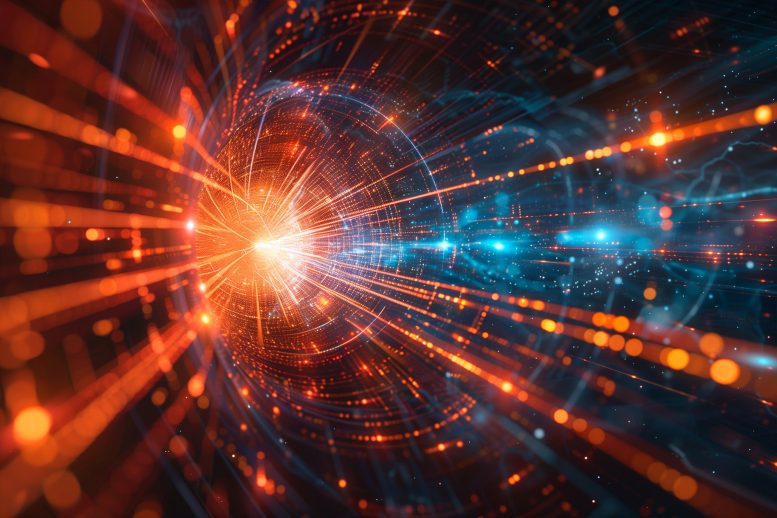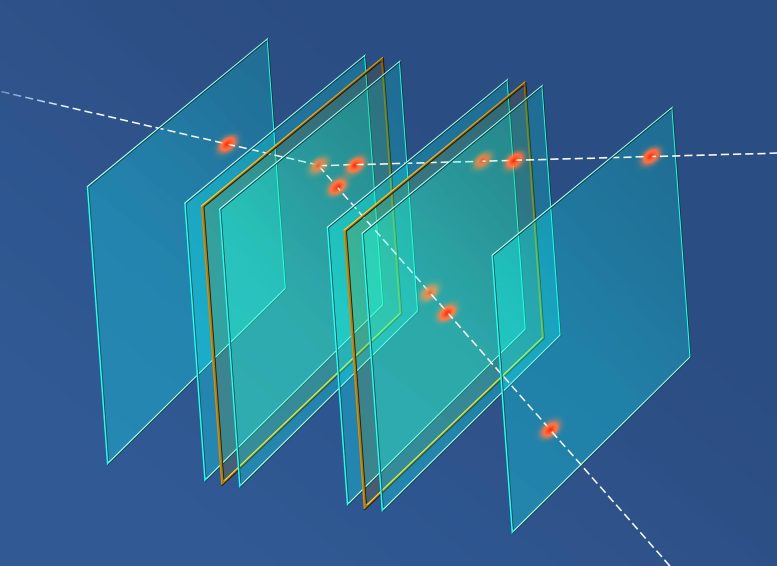By

AI is emerging as a key tool in nuclear physics, offering solutions for the data-intensive and complex task of particle track reconstruction. Credit: SciTechDaily.com
Particles colliding in accelerators produce numerous cascades of secondary particles. The electronics processing the signals avalanching in from the detectors then have a fraction of a second in which to assess whether an event is of sufficient interest to save it for later analysis. In the near future, this demanding task may be carried out using algorithms based on AI.
Electronics has never had an easy life in nuclear physics. There is so much data coming in from the LHC, the most powerful accelerator in the world, that recording it all has never been an option. The systems that process the wave of signals coming from the detectors therefore specialize in… forgetting – they reconstruct the tracks of secondary particles in a fraction of a second and assess whether the collision just observed can be ignored or whether it is worth saving for further analysis. However, the current methods of reconstructing particle tracks will soon no longer suffice.
AI in Particle Tracking
Research presented in the journal Computer Science by scientists from the Institute of Nuclear Physics of the Polish Academy of Sciences (IFJ PAN) in Cracow, Poland, suggests that tools built using artificial intelligence could be an effective alternative to current methods for the rapid reconstruction of particle tracks. Their debut could occur in the next two to three years, probably in the MUonE experiment which supports the search for new physics.

The principle of reconstructing the tracks of secondary particles based on hits recorded during collisions inside the MUonE detector. Subsequent targets are marked in gold, and silicon detector layers are marked in blue. Credit: IFJ PAN
The Complexity of Particle Detection
In modern high-energy physics experiments, particles diverging from the collision point pass through successive layers of the detector, depositing a little energy in each. In practice, this means that if the detector consists of ten layers and the secondary particle passes through all of them, its path has to be reconstructed on the basis of ten points. The task is only seemingly simple.
“There is usually a magnetic field inside the detectors. Charged particles move in it along curved lines and this is also how the detector elements activated by them, which in our jargon we call hits, will be located with respect to each other,” explains Prof. Marcin Kucharczyk, (IFJ PAN) and immediately adds: “In reality, the so-called occupancy of the detector, i.e. the number of hits per detector element, may be very high, which causes many problems when trying to reconstruct the tracks of particles correctly. In particular, the reconstruction of tracks that are close to each other is quite a problem.”
Experiments designed to find new physics will collide particles at higher energies than before, meaning that more secondary particles will be created in each collision. The luminosity of the beams will also have to be higher, which in turn will increase the number of collisions per unit time. Under such conditions, classical methods of reconstructing particle tracks can no longer cope. Artificial intelligence, which excels where certain universal patterns need to be recognized quickly, can come to the rescue.
AI as a Solution
“The artificial intelligence we have designed is a deep-type neural network. It consists of an input layer made up of 20 neurons, four hidden layers of 1,000 neurons each and an output layer with eight neurons. All the neurons of each layer are connected to all the neurons of the neighboring layer. Altogether, the network has two million configuration parameters, the values of which are set during the learning process,” describes Dr. Milosz Zdybal (IFJ PAN).
The deep neural network thus prepared was trained using 40,000 simulated particle collisions, supplemented with artificially generated noise. During the testing phase, only hit information was fed into the network. As these were derived from computer simulations, the original trajectories of the responsible particles were known exactly and could be compared with the reconstructions provided by the artificial intelligence. On this basis, the artificial intelligence learned to correctly reconstruct the particle tracks.
“In our paper, we show that the deep neural network trained on a properly prepared database is able to reconstruct secondary particle tracks as accurately as classical algorithms. This is a result of great importance for the development of detection techniques. Whilst training a deep neural network is a lengthy and computationally demanding process, a trained network reacts instantly. Since it does this also with satisfactory precision, we can think optimistically about using it in the case of real collisions,” stresses Prof. Kucharczyk.
The MUonE Experiment and Future Physics
The closest experiment in which the artificial intelligence from IFJ PAN would have a chance to prove itself is MUonE (MUon ON Electron elastic scattering). This examines an interesting discrepancy between the measured values of a certain physical quantity to do with muons (particles that are about 200 times more massive equivalents of the electron) and predictions of the Standard Model (that is, the model used to describe the world of elementary particles). Measurements carried out at the American accelerator centre Fermilab show that the so-called anomalous magnetic moment of muons differs from the predictions of the Standard Model with a certainty of up to 4.2 standard deviations (referred as sigma). Meanwhile, it is accepted in physics that a significance above 5 sigma, corresponding to a certainty of 99.99995%, is a value deemed acceptable to announce a discovery.
The significance of the discrepancy indicating new physics could be significantly increased if the precision of the Standard Model’s predictions could be improved. However, in order to better determine the anomalous magnetic moment of the muon with its help, it would be necessary to know a more precise value of the parameter known as the hadronic correction. Unfortunately, a mathematical calculation of this parameter is not possible. At this point, the role of the MUonE experiment becomes clear. In it, scientists intend to study the scattering of muons on electrons of atoms with low atomic number, such as carbon or beryllium. The results will allow a more precise determination of certain physical parameters that directly depend on the hadronic correction. If everything goes according to the physicists’ plans, the hadronic correction determined in this way will increase the confidence in measuring the discrepancy between the theoretical and measured value of the muon’s anomalous magnetic moment by up to 7 sigma – and the existence of hitherto unknown physics may become a reality.
The MUonE experiment is to start at Europe’s CERN nuclear facility as early as next year, but the target phase has been planned for 2027, which is probably when the Cracow physicists will have the opportunity to see if the artificial intelligence they have created will do its job in reconstructing particle tracks. Confirmation of its effectiveness in the conditions of a real experiment could mark the beginning of a new era in particle detection techniques.
Reference: “Machine Learning based Event Reconstruction for the MUonE Experiment” by Miłosz Zdybał, Marcin Kucharczyk and Marcin Wolter, 10 March 2024, Computer Science.
DOI: 10.7494/csci.2024.25.1.5690
The work of the team of physicists from the IFJ PAN was funded by a grant from the Polish National Science Centre.


